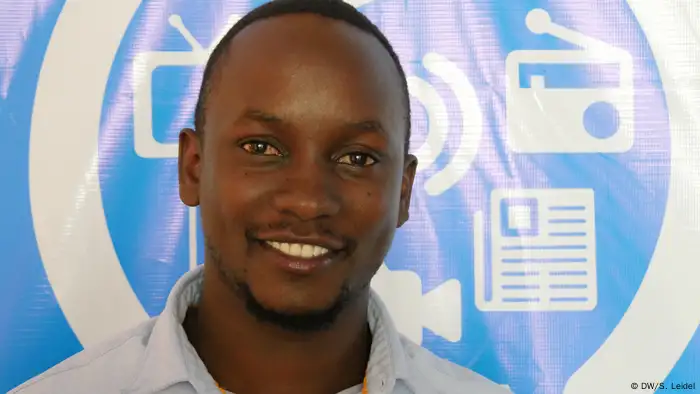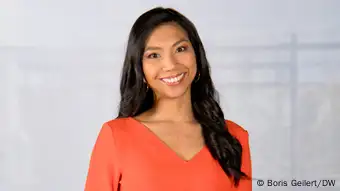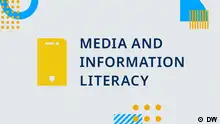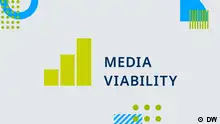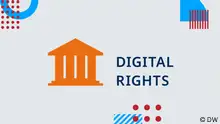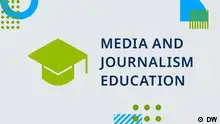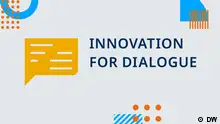Podcast
Abaas Mpindi of MCI Uganda: How to survive and thrive as a media NGO with a systemic focus on youth | The Media Viability Podcast S02E02 transcript
Our second guest of 2024 is Abaas Mpindi, CEO of MCI Uganda. The youth-driven NGO prides itself in training the next generation of journalists – while also running a solutions journalism newsroom.
Welcome to "Survive and Thrive," DW Akademie’s dialogue with media managers on innovative and sustainable business models in a challenging global media landscape. We'll talk motivation, lessons learned, funding models, best practices, recipes for success and decisions – both good and bad.
Watch here, or read the complete transcript below
Janelle Dumalaon (host): Hello again, and welcome to Survive and Thrive, the media viability podcast. And as in every episode, we're talking about the multifaceted challenges involved in doing exactly that: not just surviving but thriving.
Now, if you lead a media outlet, you would know how much of an uphill climb it can be to operate and produce journalism every single day while coming up with new ideas and fresh models, despite funding issues and skill gaps in media literacy questions.
Given that it's helpful for media producers to share their experiences and enrich the collective pool of insights we've now drawn from, our next guest believes in starting young. Abbas Mpindi is the founder and CEO of Media Challenge Initiative. Welcome! MCI is a youth-driven nonprofit training the next generation of African journalists. We'll get into what all of that means in a second. But first, this quick questionnaire.
Your business model in a catch phrase.
Abaas Mpindi: Thank you so much for having me, Janelle. It's a pleasure. I would say community, community, community.
Second question: Did you ever manage a moment when everything seemed lost?
Mpindi: Yes. In 2016, after four years of running a volunteer journalism training program, we were on the edge of giving up. We didn't have any funding to run the programs training young journalists. So, we decided to say, “this is it, this is over.” But we were very, very lucky at that point because we had the idea of creating a video proposal. It went like “Hi, I’m Abaas Mpindi and I am the CEO of Media Challenge initiative. We are making this video to propose a project building the next generation of journalists and we would love you to provide support and funding,” and we included the team and created some animation which was like a creative video proposal.
And at that point, that was not something that most partners in Uganda had seen before. Most people receive a written text proposal. The video proposal went out to different partners, including the Konrad-Adenauer-Stiftung, which got really interested in our idea, called us to their office and gave us our first grant. We really were on the edge of survival and it helped us come back to doing the work that we loved doing. It was 6,000 Euros that made us thrive again and made us believe in the work that we were doing when all of us had decided to just call it quits.
Who knew video proposals could be so consequential. Here’s your third question: What would you need to survive in the future?
To survive in the future as an organization, we need investment into the social enterprise arm of the NGO. We are trying to at least gear towards a 50/50 budget, reducing the contribution of donors and relying on donors.
Over time, if you're running a nonprofit journalism program, you want to reach a level where you can sustain it even after many years when a partner or donor is gone. And one of the creative ways to do that for us has been creating a social enterprise. That is, content business sales: People want production, people want creative content, people want storytelling and we have all of that. We also have a training background.
Including a support system for our newsroom helps us to sustain it. So, if there's anything that we want in order to thrive in the future, it's going to be investment in our social enterprise. That can be equipment, funding, and also capacity-building, training our content production team to produce high quality content that can be consumed globally.
You lead MCI Media Hub, MCI Radio, Solutions Now Africa, and you train young journalists. The way I understand it, it's kind of like a media hub modeled after tech incubators while also of course within journalism.
You've alluded to it somewhat a little bit, but can you tell us exactly how that business model works?
Media Challenge Initiative is a youth, nonprofit, based in Kampala, Uganda. Our main work is building the next generation of journalists through training, mentorship and peer-to-peer experiential learning. We do that through a fellowship program where young journalists come and are recruited from universities and get training.
And then the other thing that we do is provide incubation space through a media hub for those that want to innovate.
And then we run a newsroom called Solutions Now Africa, which focuses on telling stories, solutions journalism stories, that challenge negative narratives about Africa.
And then the MCI radio, which focuses on amplifying young African voices.
The first part of our business model is, of course, building relationships and partnerships with donors and funding partners who believe in this idea of building the next generation of journalists.
And the second is developing a social enterprise arm for the nonprofit in the form of organizing and hosting events at the media hub, content production like documentaries or success storytelling for organizations, and training. We offer capacity-building to organizations and to individuals through our media academy.
Now, when we started, I would say in 2021 after the lockdown, with the social enterprise we were around maybe a small 10% contribution to our annual budget. Now, we have moved that to around 25%. This business part of the organization is the way for us to be able to thrive and say we are viable as a media organization.
And of course, our structure is very different from a typical journalism newsroom because we are an NGO and under that we have different projects. But for those who survive, while you do need money, you need more than that: You need a community. You need a community.
So we are building a community of young journalists and a community of universities which believe in our work but which also contribute to our programming in terms of young people consuming and also working with us.
You talked about the need for money – lots of media managers will be able to relate to that – and the need to build a community and how these are sort of the pillar of the project that you're trying to develop and make viable for the future.
What have been the biggest challenges to those goals?
Let me speak for the newsroom that we run, Solutions Now Africa. When we created it, we wanted to focus on quick, cute, great journalism. Video and multimedia pieces that can be consumed on our website and on YouTube.
However, to have that team focus on the newsroom content but then have the same team go and produce the commercial content for clients is very hard. Having the same team report from the field and produce, say, a documentary for a client was challenging because looking for resources and money would reduce the time we spend on journalism stories.
So, I had to begin building a separate production unit that specifically handles work for clients because it’s very difficult to focus on journalism if you have a very small team and need that same team to be in the market looking for the money.
If I understand correctly, you hive this off into two teams. Now there's a separate production unit that deals with the commercial requests.
Yes, yes. Of course, one of the things people ask a lot is, “Don't you have a conflict of interest?”
And one way that we've tried not to get there is that most of the clients that we work with are value aligning and we make sure that they do not come into the stories that we do. We only agree on projects that we also believe are a good model that even if we turn that project into a story, it would still pass as a solutions journalism story.
We use solutions journalism techniques to document things that are working and those that happen to be connected to organizations. In some cases, rather than reporting as journalists we suggest that that could be done under the commercial arm and then we, for example, add more content for their social media.
I guess what is important in this case is also to be quite transparent with your audiences about the nature of the cooperation that you have with the companies featuring the models.
So that your audiences then aren't confused about what's journalistic output and what's a cooperation with companies.
Yes. The stories that are done commercially, we don't even put them on our news website.
If we did that, then it would have to be very, very clear that this story is supported by or was done as a success story in partnership with an organization.
But we have not put any of those stories on our platforms.
That's interesting. We were talking a little bit earlier about your business model and how MCI finances itself. Perhaps you can sort of summarize: You said 25% now comes from the business arm and the rest is made-up of grants, donations or other revenue?
Yes. We work as an NGO with different donors and partners who fund our programs like training, the fellowship, and some of the events that we organize here in Uganda.
That’s still a big bunch of our budget, but we are aware that the philanthropy landscape can change anytime due to the different factors going on in the world. So, we can't entirely rely on it with 75% of our organizational budget. Right now, it 's inevitable because that's the state that we are in, but the work that we are doing is to really aim towards reducing that.
We currently work with DW Akademie, the Konrad-Adenauer-Stiftung and some American foundations to do the NGO work with training young journalists and building the capacity of journalists here in Uganda.
I can imagine that all of this must have taken quite a bit of time to develop. It must have taken quite a bit of time and resources to build these relationships and come up with this basket of funding and operational solutions that you have today.
How has MCI changed over the years since its founding?
We’ve slowly started to build the business side of things.
In 2012, I was a university student, and I started an inter-university media competition to bring journalism students together to compete in news anchoring and reporting in sort of like a musical competition but for journalists on stage. It was really to help, you know, media industry scout talent and build talent from there.
We organized that for four years as a volunteer organization until 2016 when we transformed into a fully registered organization working with different partners. And that’s also when we started to build the structure of Media Challenge Initiative into the Media Academy which was offering paid training for young journalists who didn't qualify for our fellowship programs.
That was the moment we started to think about how to create the business arm of the organization. And then, in 2020, when we received funding from DW Akademie to create the MCI Media Hub, the structure changed dramatically. We now use the hub in three ways: We have a radio and TV studio, an event space and training rooms.
I always share this with people who are struggling with viability issues: When you have space there are so many ways you can use it. Take, for example, our radio studio. It is used by our radio presenters to do radio shows. But we also use it to provide paid-for training for anyone who wants to learn how to do radio. It is also used to produce podcasts for organizations. When we have events, it becomes an event space.
We essentially created a multipurpose center. Our TV studio can be a training room, as well. Today you could walk in there and find a TV studio where people are producing news, anchoring and reporting. The next day you'll find people there who rented the space to hold trainings. And another day you will find that the same room is being hired by a company to produce a talk show program for, like, a week.
So, we’re able to use the space creatively to allow us to achieve our vision of building the next generation of journalists, but at the same time also to generate revenue. The same thing is true for our production equipment, the cameras and computers: We use the same equipment for production and post-production, and for training young journalists, building their capacity and preparing them for jobs in the media industry.
Now recently, we have acquired a bus. We call it the “SDG media van” - a sustainable development media van. It is a newsroom. It's a mobile podcast studio that goes to communities to document stories and address their issues. The same van can be used by an organization to, for example, do community screening of movies, training local radio presenters and it can then generate resources.
So, we try as much as we can for each and every piece of infrastructure we put in place to think about how we can get it to a level where it can finance itself.
This also implies that we are pushing for creating new roles within our system. Even if you are an NGO, you need a sales and marketing team. You have to hire somebody to do that. In a traditional NGO, most people will be like, “we don't need a sales and marketing team,” but in our case, we do. We need more clients, even on retainer, to use our production services.
Clearly it's never going to be the most straightforward path, right? You’re trying to do something different here and your solutions will be kind of out-of-the-box. You're not confronted with the same problems that everyone else is confronted with. You talked about multi-purpose rooms, you've talked about how the many different parts of your organization have to work in concert with each other and contribute different things.
And I can also imagine this has the function or the intention of bringing many kinds of different people together and many kinds of different competencies. You've highlighted the role of community and how important it is.
So, what does community mean to MCI and why is it so relevant for your purpose?
For me, it's personal because I grew up with my grandmother and extended family. I see the importance of being raised by uncles and aunties – being like a village child. That is a value system in many African settings and especially here in Uganda: If you don’t incorporate that community value into your business, it's going to crumble. People here own businesses and believe in businesses, because they think about and feel like being part of them.
Part of my work as the CEO of MCI is to build our community of young journalists. We have a whole alumni program that engages young journalists who have been through our fellowship. And this is not about now. It's about 20 years from now and where those young journalists are going to be, the positions they're going to hold, their leadership values. They will be able to spread news around the world. I’m thinking about 20 years from now that community could probably include a million people. And where will they be? What powers will they have to influence policies as a community? If they stick together, they can create change in their communities.
Even right now, they have outreach programs that they do together: professional development trainings, fun activities. And for some, the community is even therapeutic. If they deal with mental health challenges, they know that there is a community that supports them.
Now, when it comes to the subject of the day, of course, which is media viability: Here people even have fan clubs for radio stations. Why? Because they feel they belong. These people will believe in your news, they will believe in your stories because you have developed trust over time. Community ultimately is about trust. It’s also about knowing that as a media platform, you're not only there when they are in need, but also when they're celebrating.
For us as journalists, we need to understand that – especially now with digital platforms. Even small loyal communities online help, because community then becomes money.
If in 20 years, your community is probably going to be one million people - where are we now?
Right now, we have around 3,000 young people who have gone through our trainings. So, one million is probably too high a number, but I’m thinking about what if we can sustain the programs that we have and create more programs training young journalists in different communities? What impact can we create through their reach?
Our core community that we build are the people who have gone through the fellowship. Over the past five years, that has been around 180 people and their impact in the Ugandan media industry is very big. They are now news anchors, reporters, writers, editors, producers. Even if we stopped at 180 – in a small media industry in Uganda over the next ten years those young people will move into high positions as media owners, senior editors, managers and they will have a say on the economics and politics of the country.
And then there's the extended community where you have trained someone once and they associate themselves with MCI because they learned something.
For me, supporting those young people today means investing in educated citizens tomorrow, better journalists and better leaders in the journalism industry. And that is not just a benefit for the media industry to survive or thrive, but for the country and for a continent like Africa where we have the youngest population.
There’s a ripple effect that comes with this kind of investment. Now, it looks like a small fellowship program, but it changes that person's life for years and years and it also changes their family, it changes the children that they will have. It looks like a journalism skills program, you work on the radio, you work with Solutions Now – but it's a lifetime thing.
That's the thing with change: It can start incrementally and, of course, it can compound over time.
And when young journalists come to you for training, what do you find is the biggest issue you have to work on? I would imagine, for example, that a lot of training must be done on media literacy. I can imagine media literacy to be a top topic whenever dealing with the very young who perhaps still have yet to understand the full importance of trying to build resilient media institutions. What can you say about media literacy among young aspiring journalists in Uganda?
Of course, even building the skills of journalists is still media literacy. It's the idea of understanding how the media works and the power the media has to break or make communities and the power that journalists themselves have – and how they can fall prey to dictators or rich people that have their own interests and use that to create chaos in communities.
We train them first and foremost to understand the power they have and how they will be targeted, can be abused and used by different players. Then, once you understand the power that you have as a journalist, you also need to understand the skills that you have as a media literate journalist to change the world.
Another part of course, which is typical now, is training around fact checking, dealing with misinformation and disinformation and how you can build the capacity of communities as a journalist to create a media literate public. We know that the stories that we do as journalists can make the public more media literate. And once the public is literate, they can consume and demand better journalism and quality journalism – and they might be willing to pay for it, because now they know why that information is important. They understand the role of journalists in the community and why they are important.
Additionally, media literacy for journalists for us also includes training our young journalists to understand the business behind the media. They have to know that every story generates cost, there's an investment behind every story. And if they produce a very, very good story that fosters conversations and gets communities talking and gets action out there in terms of policy, the more they draw audiences to the media house.
That's an understanding that they need.
I think this is a really important point that often gets lost. Obviously, being in the media comes with a certain kind of influence, and it is to be wielded responsibly and judiciously.
I wanted to go back to something that you said very early on in our conversation about how it was important to you to use your platform to dispel negative stereotypes about Africa.
What are we talking about there and how do you do that?
Hundreds and hundreds of years of portraying the continent as diseased, as poverty-stricken, as devoid of potential and a place where you can't invest... Over the years, we’ve seen that Africa is treated as a charity case and that is due to years and years of not just media coverage but also media campaigns that have been done by aid agencies.
The way the world sees and interacts with Africa is highly dependent on the stories people have consumed in the movies, in the papers, in project adverts, and all these media campaigns. And if people have a negative view of the continent, if they wanted to invest, you know with young Ugandans, they’ll think negatively first. They’ll say: “Oh, you’ll never make any money from that.”
So what we're trying to do is: Let's change how people see the continent! We're not saying we want positive stories only. We don't want one-sided, positive stories. We’re saying we want the whole story. We want what's not going well, but we also want what's going well and highlight these efforts of young Ugandans, young Africans and even governments and NGOs and different stakeholders working to change the different challenges on the continent. We don’t often see that spotlighted in the media, right?
So, our newsroom Solutions Now Africa focuses with a huge bias on things that work on the continent. And I also think that from an advocacy perspective and when it comes to the conversation of media viability: If you're a media platform and you continue portraying any group of people as less than you, you are basically also eating into your money.
Because we see you. People see you. They will call you out. If you claim to be for media freedom, for example, you should be actually seen to be providing that freedom to each and every one in a fair and just way. If you're marketing to your sponsors and advertisers and, say you have a huge reach in African markets but then the content and news that you have on your platform is only negatively driven and never shows that there’s actual potential, that's basically a double standard.
We are trying to call out and say “change that”.
If you're making money out of those communities through different ways, you can as well recognize their full humanity.
Yeah, for humanity's sake, at least.
Abaas, we can talk all day long about these things but we're getting to the end of our time now.
And before we let you go, we want to ask you whether you have three best practice tips for any of the media managers out there who might be open to learning about your experiences.
For me, the first one is people first, people-centered reporting. No one wakes up to go online to look for problems. We still need, of course, coverage on challenges. But people are not looking for problems. One way to thrive, to make your business grow, is to provide solutions to people that they are looking for. Look at the challenges they face and work towards contributing to how they can thrive as a community. Because they want you not only to be there when they have problems. They want you to actually be there to help them and support them to get out of those problems.
People first helps you build the community.
Community is number two and it’s very important because people, especially here in Uganda and I would say some African countries are like “Are you for us? Do you speak for the people or do you speak for a certain group of people?” You make that decision. Do you speak for a certain group of people because that's where you probably get your money from, or do you represent the issues of the entire community in an objective way?
And I know this is controversial, especially even in places where media houses get money from one source, like, 70% of the budget comes from the government. And then people don't see their voices represented in the media.
And my third tip would be on creativity around how you use your platforms, as well as spaces. I have shared extensively how we use our media hub and the equipment and the tools we have. The journalists are also more than just reporters. They are influencers. So, can you build incredible voices and profiles of journalists to become, you know, an asset for your organization? Are you investing in your journalists to not only be just reporters you send to collect news, but to become influential figures? That is an investment for them and in the future.
We know that journalists were the first influencers even before we had the social media influencers that we have today. So, I would say: invest in journalism because the quality that the communities are demanding comes from journalists who are skilled and journalists who you are invested in.
Let’s see if I’ve got it all together. Put people first – people are looking for solutions, not problems and therefore, it's very important to discuss the challenges that people are facing and find solutions towards them. Secondly, build the community. It’s very important to show the community that you speak for the people and not for a certain group of people. And be creative with your platforms and spaces, both online and in the real world.
100%, you got it.
Thank you so much to our guest today. You were listening to the CEO and Founder of Media Challenge Initiative.
This transcript of "Survive and Thrive: The Media Viability Podcast" has been lightly edited for clarity.
Get in touch
For questions and suggestions write to dw-akademie.surviveandthrive@dw.com
Or find us on Twitter, Facebook, LinkedIn and Youtube.
This podcast is produced by DW Akademie and is supported by the Federal Ministry for Economic Cooperation and Development (BMZ).
Media viability
Earlier episodes
- Date 24.02.2024
- Keywords DW Akademie, media viability, survive and thrive, podcast, Media Management, media business, Uganda, Media and journalism education, youth media, stereotypes, Africa, media hub, entrepreneur, solutions-oriented journalism
- Feedback: Send us your feedback.
- Print Print this page
- Permalink https://p.dw.com/p/4ckZE
- Date 24.02.2024
- Keywords DW Akademie, media viability, survive and thrive, podcast, Media Management, media business, Uganda, Media and journalism education, youth media, stereotypes, Africa, media hub, entrepreneur, solutions-oriented journalism
- Send us your feedback.
- Print Print this page
- Permalink https://p.dw.com/p/4ckZE

